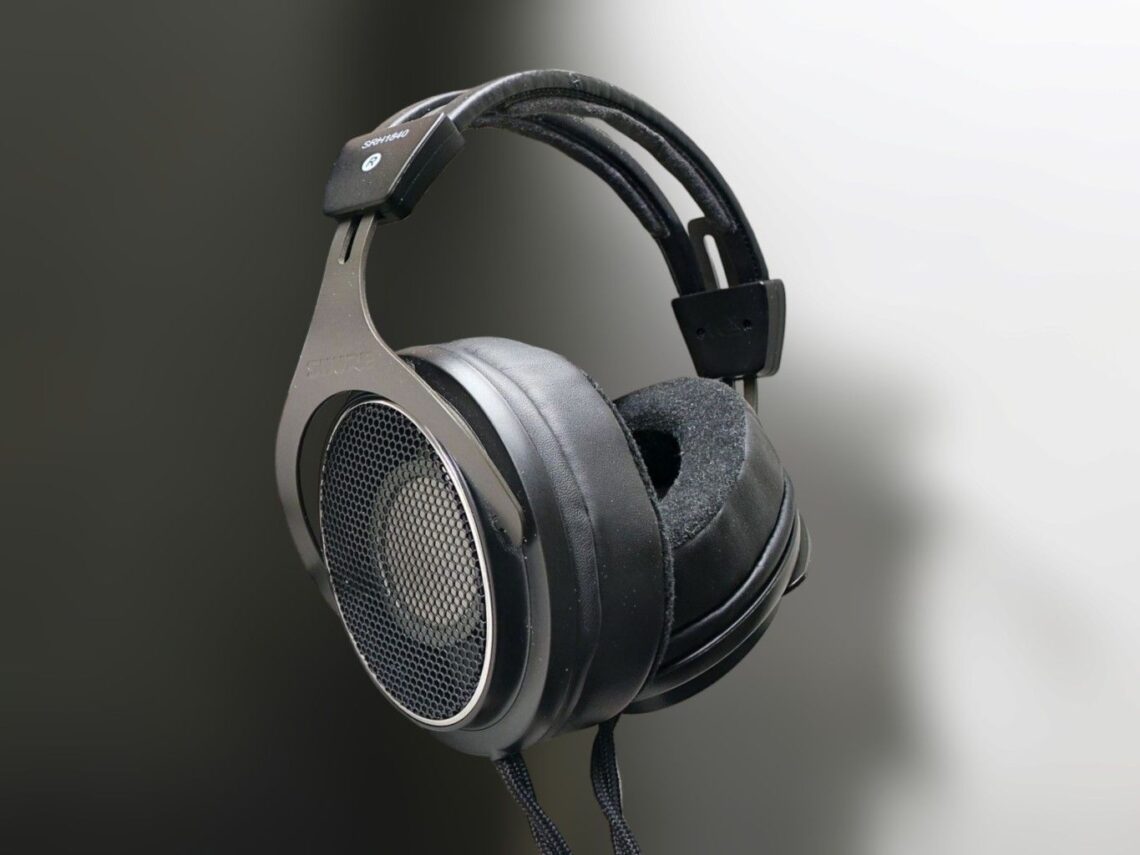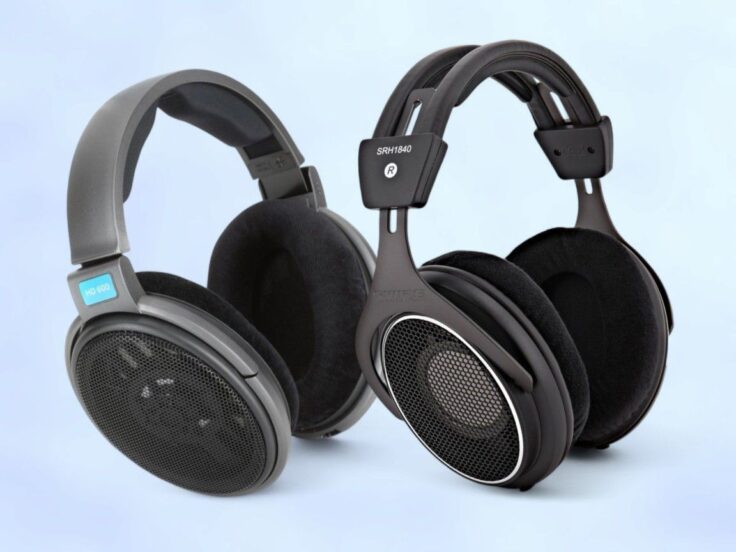Great headphones – if and only if – you give them the right pads!
While some companies obsess about releasing new models almost every year, some just make a good headphone and let it be the same for decades. The Sennheiser HD600 and HD650 are classic examples, as is the AKG701.
The Shure SRH1840, on the other hand, is something of a curiosity. It has been on the market since 2012, with consistently high pricing and continued availability in professional audio outlets. According to Shure, it has not been updated or revised since its launch. Yet, despite its long presence and professional positioning, it receives relatively little attention in enthusiast communities like Head-Fi or Reddit.
That it’s been on the market this long might lead one to conclude that it must deliver the goods. You might assume its longevity stems from its neutral tuning, durable build, and light, comfortable design. It features a pair of matched 40mm dynamic drivers and has a sleek, timeless aesthetic.
However, as you’ll see from this review, and as many users online seem to agree, the SRH1840 is in many ways a flawed headphone, with notably lacking bass and occasional serious distortion issues. That said, there’s a surprisingly effective fix for these problems, and discovering it has been a genuine revelation.
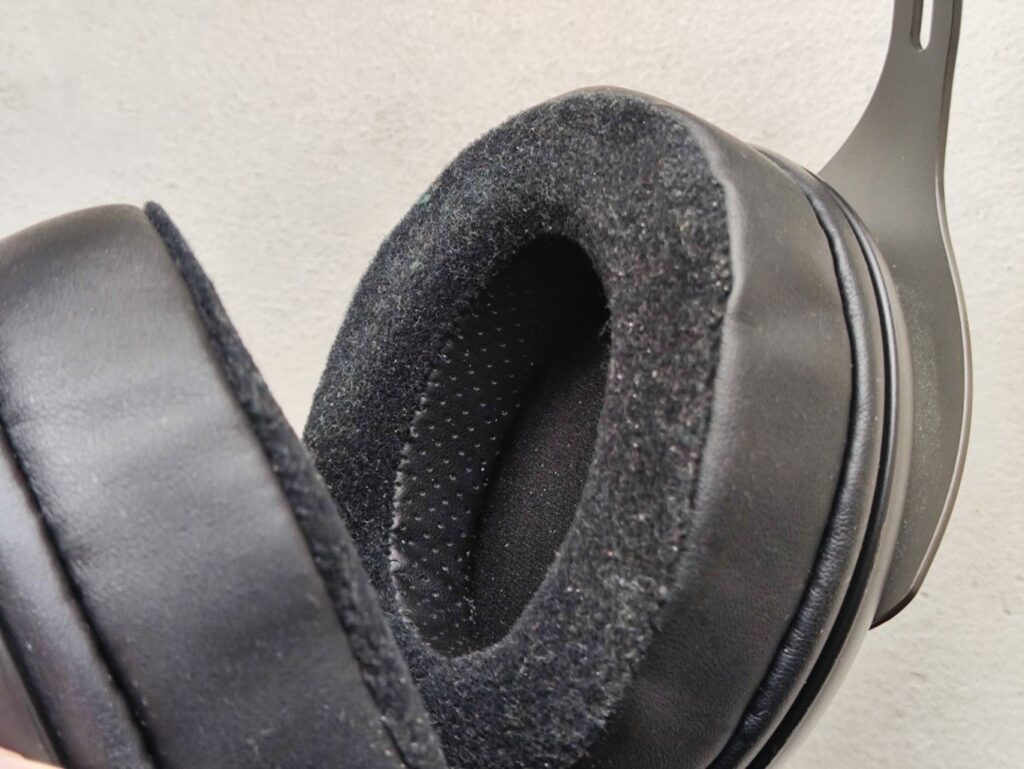
THE FIX: A MAGIC PAD SWAP
I’ve always liked the SRH1840 for some reason. It was never my favorite all-rounder, but there’s something uniquely appealing about its midrange presentation. However, while reviewing it more critically, the flaws became impossible to overlook—noticeable distortion, particularly in the lower regions, and a significant bass roll-off that undermines its overall performance.
I began to suspect that the SRH1840’s underwhelming bass and distortion issues stemmed from a lack of acoustic resistance. While the stock velour pads are extremely acoustically transparent, the headphone’s design isn’t truly open-back in the traditional sense. There are no fully open vents on the ear side—airflow is instead regulated by a fine internal mesh surrounding the driver, which is also partially covered by a circular disc on the exterior.
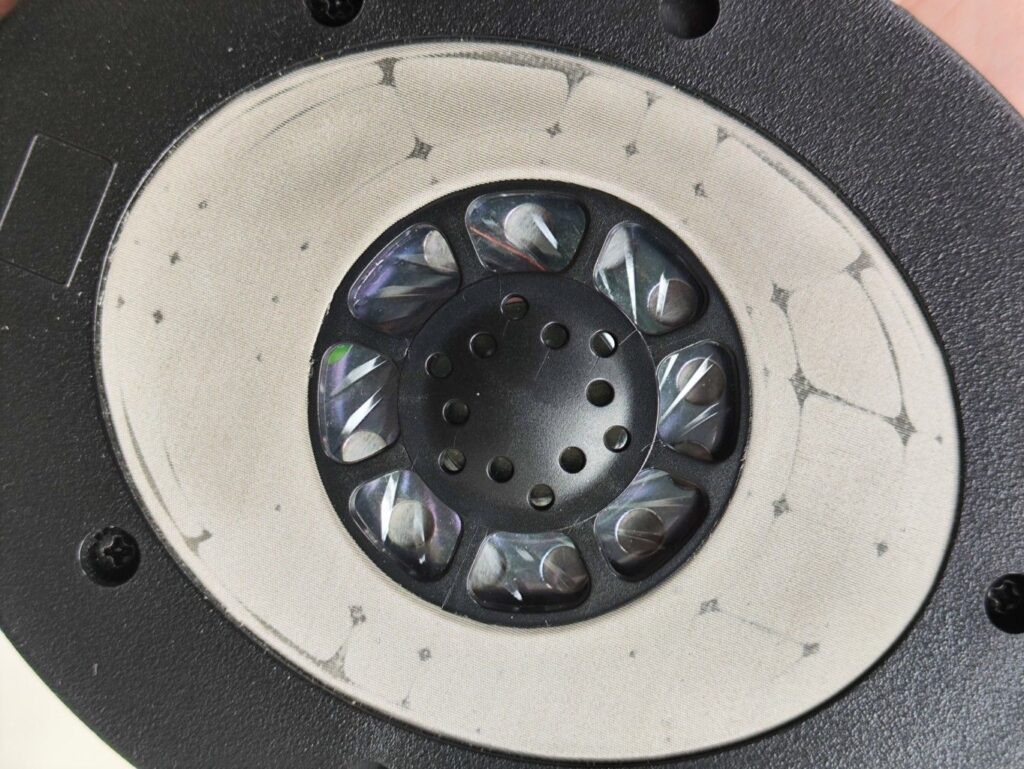
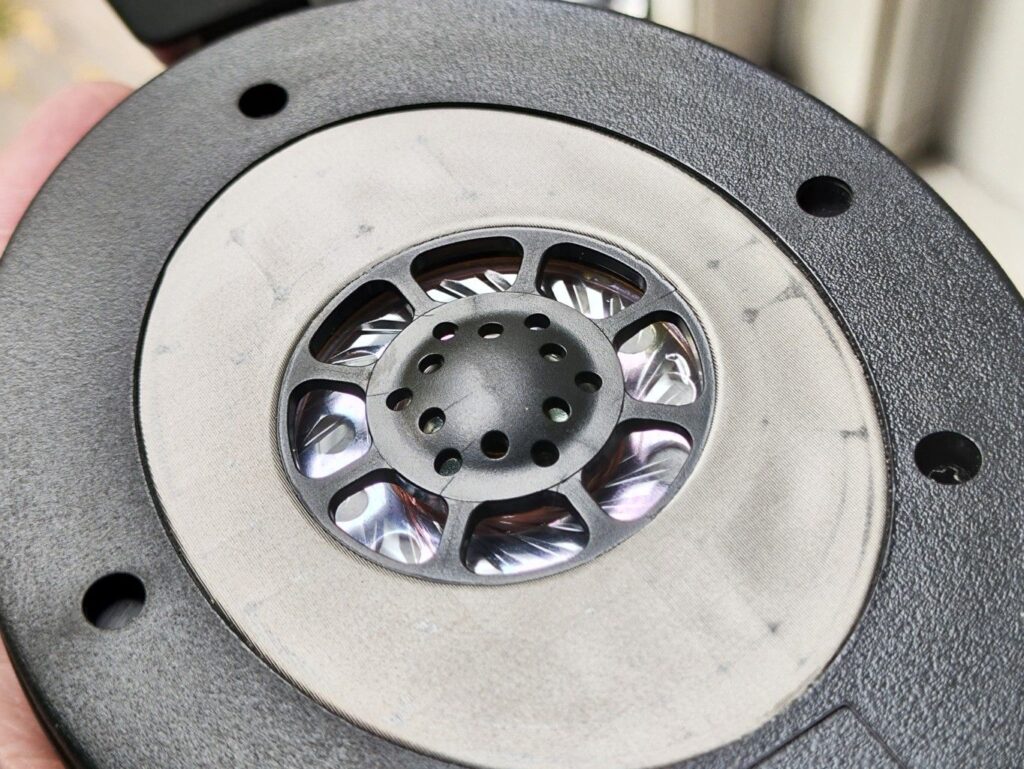
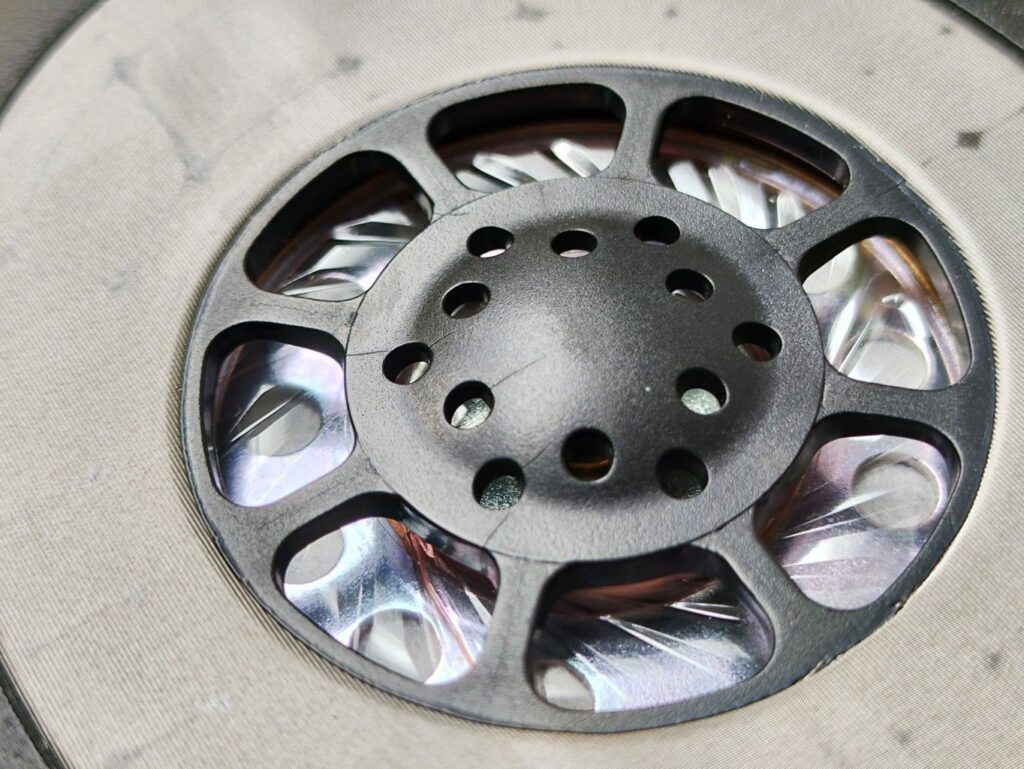
With the stock pads, much of the airflow bypasses this intended resistance by escaping through the porous pad material. By replacing them with denser pads, the airflow is forced to interact primarily with the internal mesh and driver housing as originally designed. This change fundamentally alters the operating conditions of the driver—and the result is transformative. In all my years of headphone testing, I’ve never experienced a pad swap as dramatically effective as this one.
In fact, I tested three different types of pads—each significantly denser and more isolating than the stock velour pads—and all delivered similarly impressive improvements in sound quality. Among them, my preferred choice was the Brainwavz Oval Hybrid Pads. These uses quite dense ministry foam and feature a combination of perforated (fenestrated) synthetic leather on the inner wall, non-perforated synthetic leather on the outside, and velour on the face. This combination strikes a great balance between acoustic control and comfort.
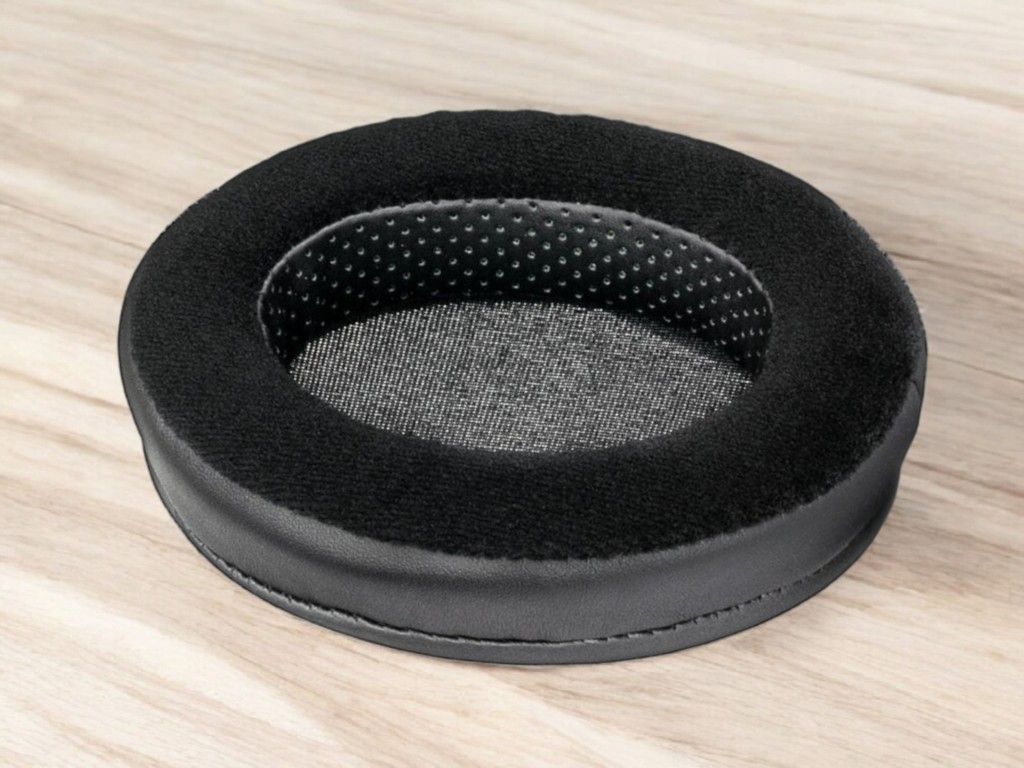
That said, if you have personal preferences for different materials—be it for comfort, durability, or aesthetics—I can confidently recommend any of the three denser pad options I tested. They all yield a substantial upgrade over the stock configuration:
- Amazon: Brainwavz Oval Hybrid Pads
- Amazon: Brainwavz Oval Micro Suede Pads
- Amazon: Accessory House Global Full Sheepskin TH900 Compatible Pads
For the remainder of this review, I will refer to the Brainwavz Oval Hybrid Pads mostly as “Hybrid Pads.” These are the only alternative pads I will mention or reference throughout.
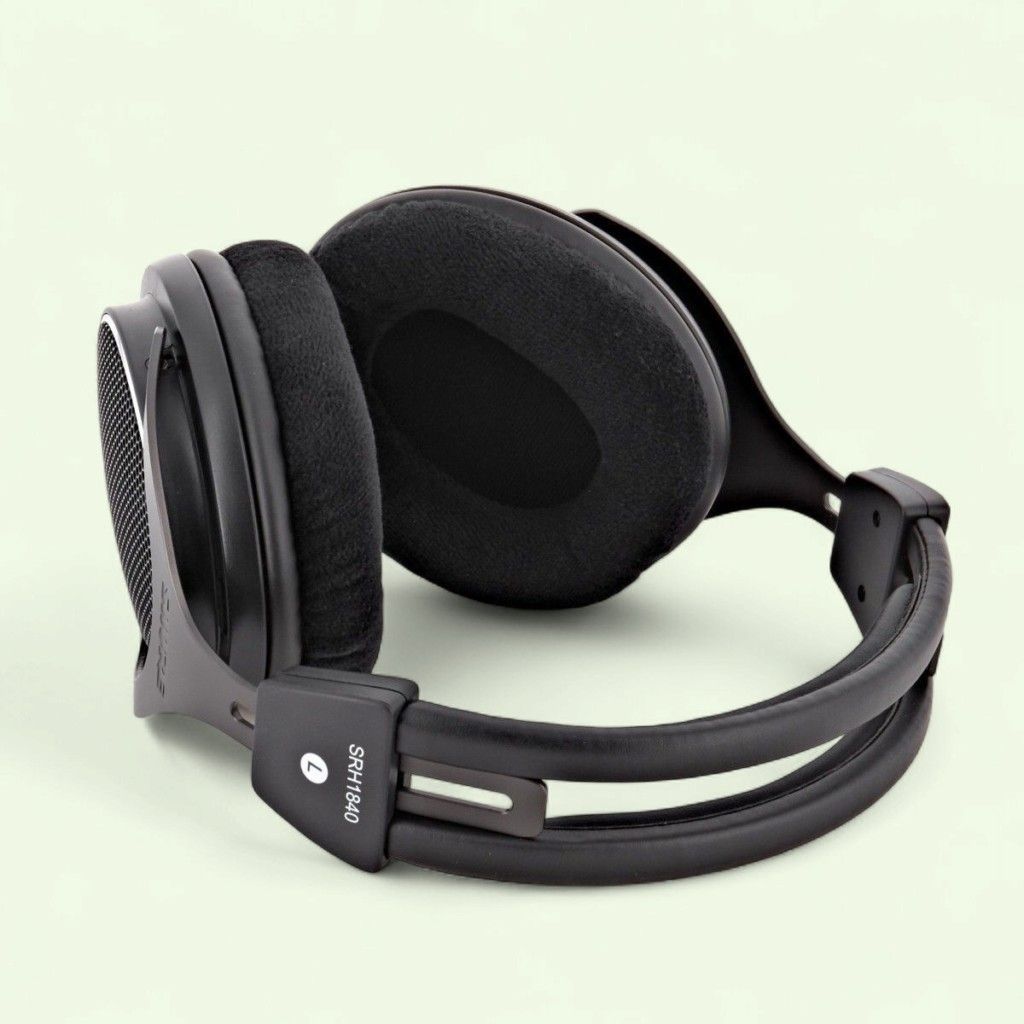
MAIN TAKEAWAY: STOCK VERSION
- Excellent upfront mid-range rendition
- Mid-centric tonal balance
- Very poor bass control
- unimpressive imaging and general detail level
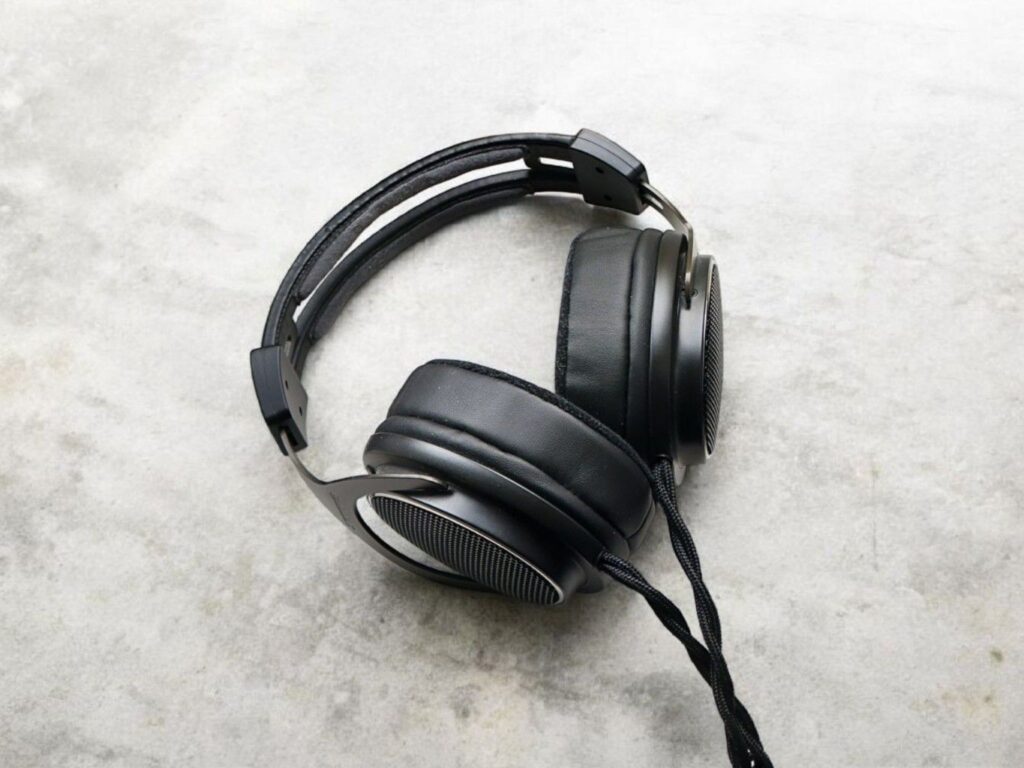
MAIN TAKEAWAY: ALTERNATIVE PADS
- Total transformation for the better
- Excellent tonal balance
- Great all round performance
- Bass improves radically
- Impressive general detail level
- Great imaging
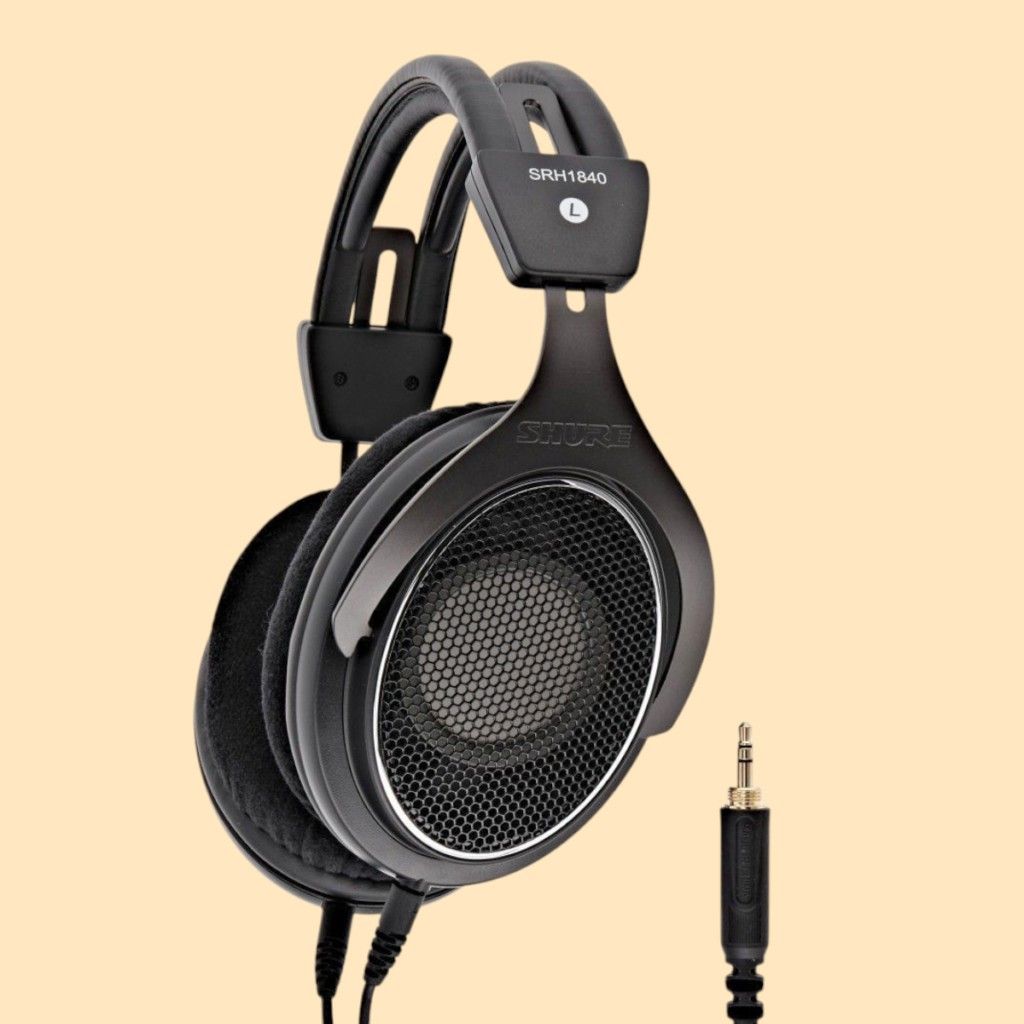
SHURE SRH1840 SPECIFICATIONS
- Type: Open-back, circumaural
- Driver: 40mm Dynamic
- Frequency Range 10 – 30,000 Hz
- Sensitivity: 96 dB/mW
- Impedance: 65 Ohms
- Maximum Input Power: 1000 mW
- adapter
- Cable: 2 x 2.1 meters (6.9 ft) straight, dual-exit, detachable oxygen-free copper
- Cable connectors on headphone cups: MMCX
- Cable termination: 3.5 mm stereo plug with threaded 1/4″ (6.3 mm) gold-plated adapter
- Replaceable ear pads
- Not collapsible
- Weight (without cable) 268g (9.4 oz)
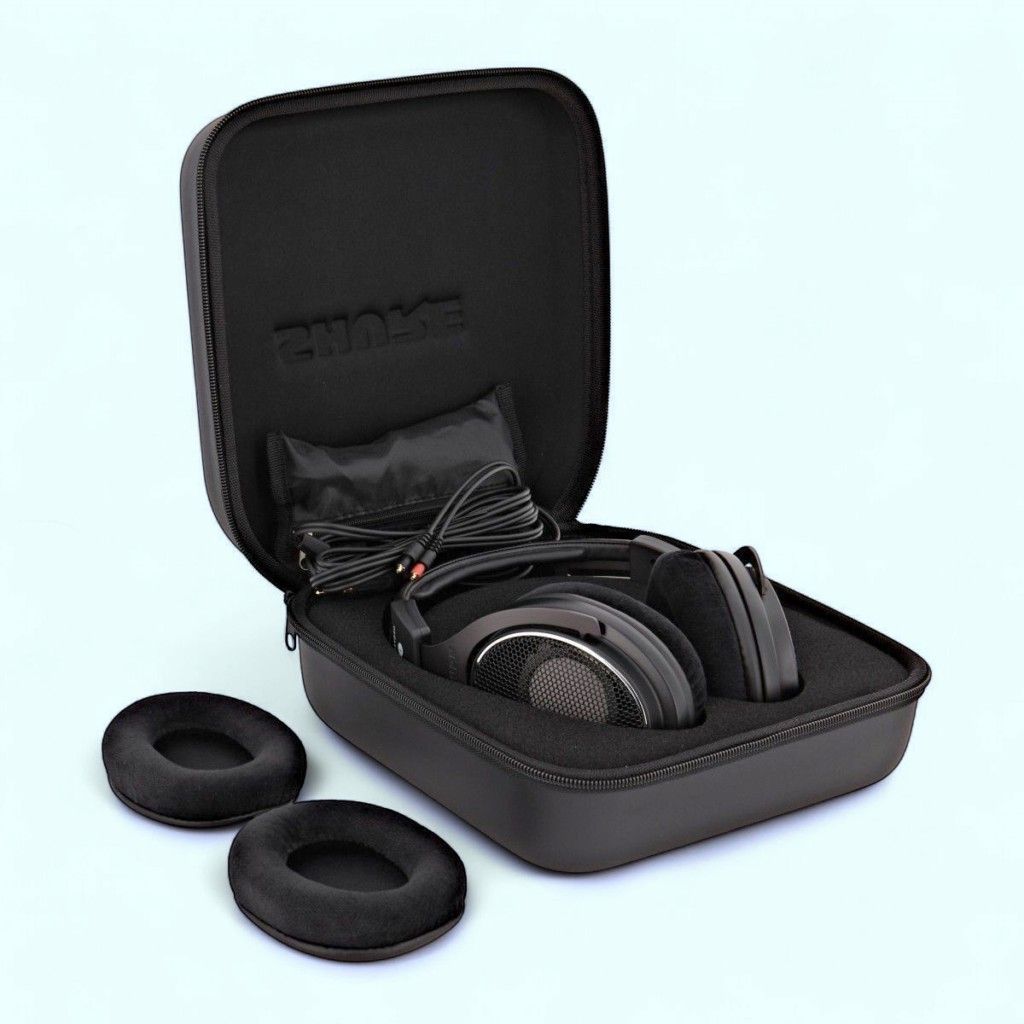
SRH1840 ACCESSORIES AND REPLACEMENT PARTS
- Replacement Velour Ear Pads: HPAEC1840
- Threaded ¼” (6.3 mm) Adapter: HPAQA1
- Travel Case: HPACC2
- Replacement Cable: HPASCA2
IN THE BOX
- Headphones
- Extra pair of velour ear pads
- two detachable cables
- TRS adapter 3.5mm to ¼” (6.3 mm) gold-plated
- Travel case with zipper
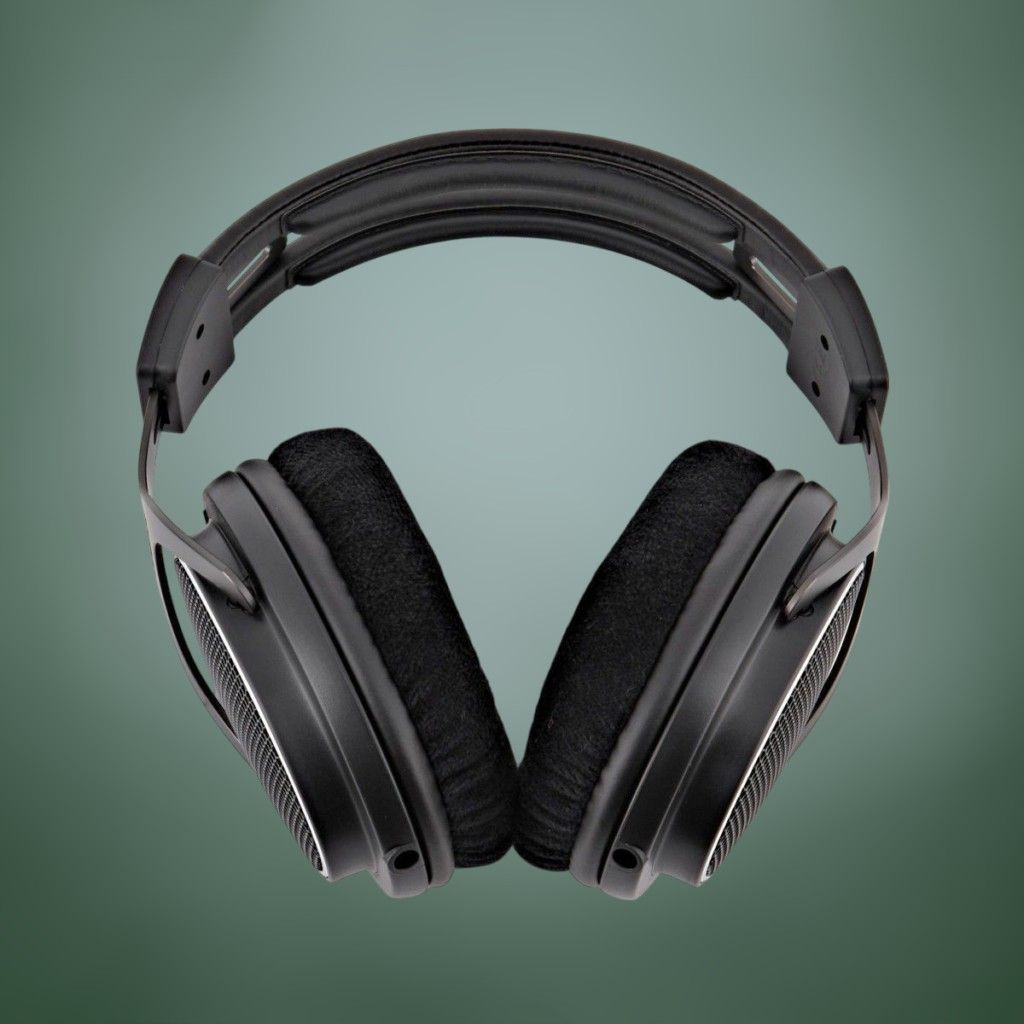
BUILD AND DESIGN
The Shure SRH1840 is equipped with carefully matched 40 mm dynamic drivers, ensuring consistent sound between channels. It features an open-back, over-ear design with breathable stock velour pads. The lightweight yet durable build includes an aluminum yoke, stainless steel grilles, and a padded dual-frame headband. Dual-entry gold-plated MMCX cables provide secure, detachable connectivity. Note: my personal sample has a hard wired, upgraded balanced cable from Norne Audio.
The SRH1840 comes with a two-year manufacturer warranty.
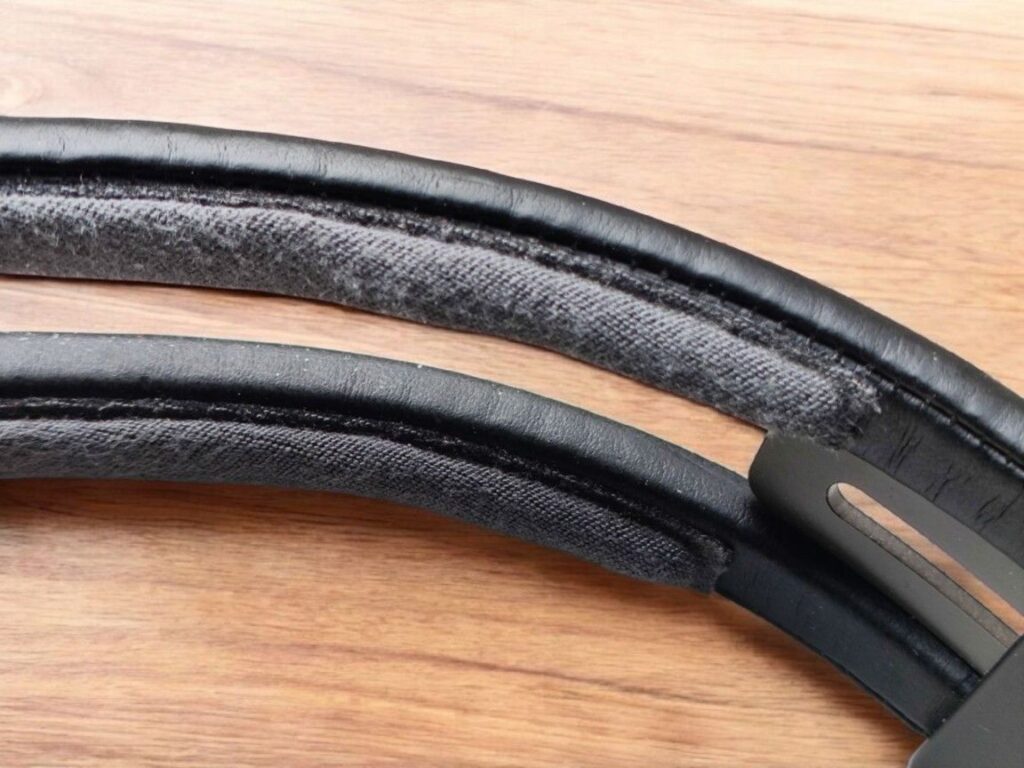
One issue I encountered with the headband was that the small padding began to flake. Initially, I thought this would be a significant problem, but after gently rubbing off the deteriorating black material, I discovered a woven fabric underneath that was surprisingly comfortable—and ultimately preferable.
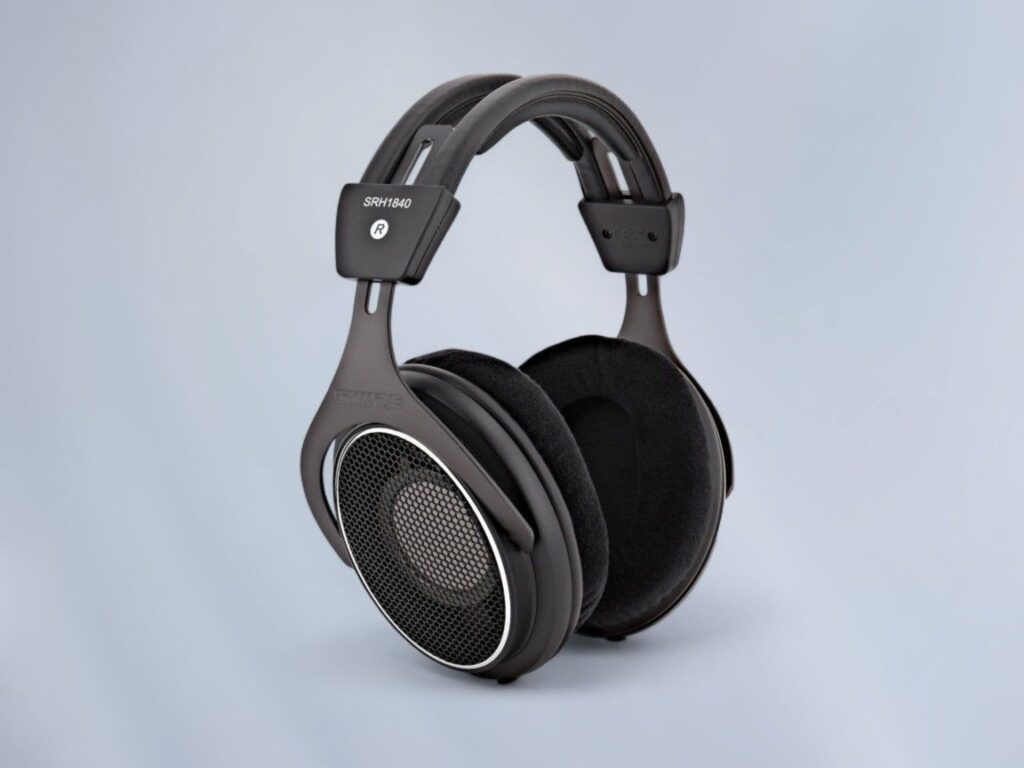
LISTENING IMPRESSIONS
First, I went through my playlist using the stock pads. While I wasn’t especially satisfied with what I heard, there are definitely aspects that the stock Shure SRH1840 gets right.
Then, I listened to the same tracks on the SRH1840 with the hybrid pads and noted the changes. As you’ll see, the differences are quite significant.
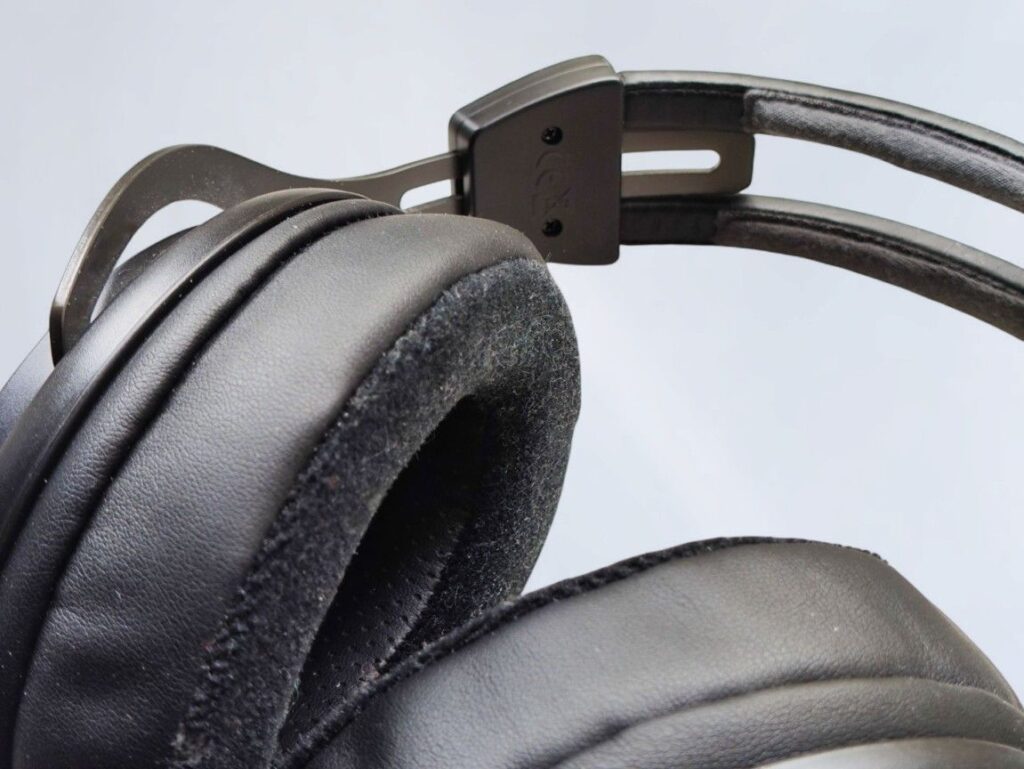
Jambi by Tool
STOCK PADS: The guitars are richly textured, and the vocals stand out clearly with a natural tone. Sibilance is well-controlled—present but not irritating. Like most open-back dynamic headphones in this category, deep bass is limited and rolls off, emphasizing a midrange-focused sound. Detail retrieval is solid. The soundstage feels open, though not particularly expansive, and while imaging isn’t razor-sharp, there’s a clear sense of foreground and background separation with good background detail.
HYBRID PADS: The guitars are not only textured but also fuller and more bodied. Bass is well-extended with no noticeable roll-off. Vocals remain prominent and naturally presented. Imaging is a significant improvement—more precise and defined—while instrument separation is markedly better. The tonal balance feels very natural and cohesive throughout.
Almost Like The Blues by Leonard Cohen
STOCK PADS: The bass is slightly lacking but remains relatively well balanced. Piano comes through with clarity and a crisp character. Vocals are exceptionally well rendered, presented in a forward and engaging manner. Percussion is snappy and lively. The soundstage feels spacious, though somewhat diffuse in its precision.
HYBRID PADS: The bass is deeper and significantly more present, comparable to headphones known for excellent low-end performance. Vocals are full-bodied and natural—less brightly forward, but still very present and well balanced. Percussion sounds more natural and integrated, blending smoothly with the rest of the mix. The soundstage is notably more precise, and imaging is impressively accurate.
Black Crow by Cassandra Wilson
STOCK PADS: Here, the soundstage and imaging are improved, offering a refined sense of separation and spatial depth between instruments. Vocals remain excellent—upfront but still well balanced and neutrally tuned, with a smooth and engaging character. Bass is present but still rolls off. Detail retrieval is quite strong, and percussion remains snappy and well-defined.
HYBRID PADS: Bass is much more present and no longer rolls off, yet it remains controlled and never overwhelming. Vocals continue to shine—natural, balanced, and engaging. Imaging is significantly improved, with greater precision, and details are cleaner and presented more effortlessly.
Some Day My Prince Will Come by Coryell Miroslav Quartet
STOCK PADS: Even though the deepest bass rumble is somewhat missed, this is a highly enjoyable bass and guitar pairing. The bass is present, but it gradually rolls off at the lowest end. On the upside, this allows the bass to sound more textured and detailed. The guitar has excellent timbre and comes through beautifully.
HYBRID PADS: The bass is fuller with no roll-off. The guitar sounds cleaner and more effortless.
Bored by Deftones
STOCK PADS: Very textured sounding guitars, clear and present vocals. Snappy percussion. The bass lacks rumble but it’s there.
HYBRID PADS: The guitars retain rich texture but sound more nuanced, as do the vocals. Bass is noticeably fuller. Percussion is less crisp but integrates more naturally with the rest of the mix.
Desert Island Disk by Radiohead
STOCK PADS: Excellent guitar timbre with detailed string work. Vocals are beautiful and well-rendered. Ambient sounds are clear and detailed. Very nice overall.
HYBRID PADS: Bass is much more present, adding depth without overpowering. The guitar maintains its great timbre and detail, with everything sounding more natural and effortless. Vocals are excellent—warm, upfront, and engaging.
As Before by Olga Konkova
STOCK PADS: The cajón drum sounds very nice, with plenty of detail and natural reverb—revealing nuances often missed even by more expensive earphones. Percussion remains snappy and engaging. The piano is clear and crisp, but never harsh or overly sharp.
HYBRID PADS: The sound is more full-bodied overall. The cajón drum has a deeper, fuller presence. The piano is warmer while retaining its clarity and crispness. Vocals come through as delicate and tender, with more natural nuance.
It Could Be Sweet by Portishead
STOCK PADS: Here, the lack of deep bass is a noticeable weakness, compounded by significant distortion—particularly a ringing or heavy resonance in the first few seconds of the track. While the vocals remain beautiful and the percussion dynamic, the deep bass distorts to an unacceptable level, severely impacting the listening experience.
HYBRID PADS: The deep bass is very present and quite clean, except for a few seconds in the intro where the bass still clearly pushes the driver behind its limits, causing a noticeable ringing or resonance distortion. This issue is absent in headphones like the Focal Clear MG. That aside, the SRH1840 with the hybrid pads performs very well overall, and the difference between the hybrid pads and the stock pads is truly night and day.
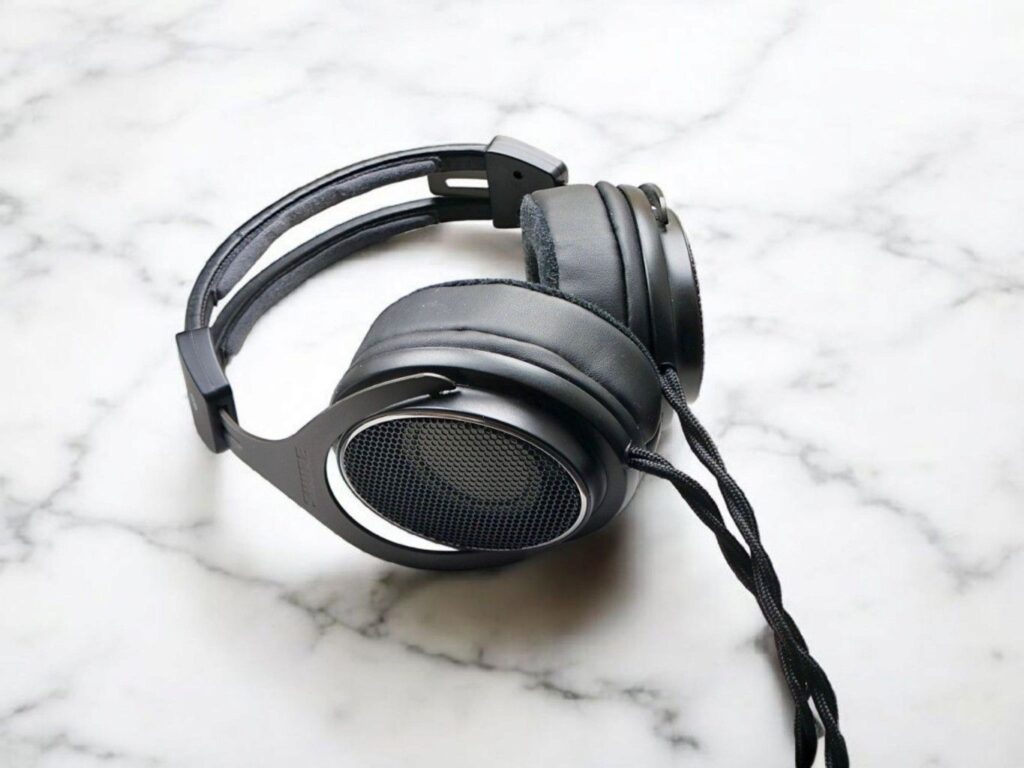
Limit to Your Love by James Blake
STOCK PADS: Another track with very challenging, deep bass—and while the vocals are lovely and energetic, the bass unfortunately distorts way too much.
HYBRID PADS: Now, the bass is much more present and most of the obvious distortion is gone. While this track tends to cause some distortion on many midrange headphones, it’s now perfectly listenable. Vocals remain lovely, and imaging has improved significantly.
Escape Route by Boris Blank
STOCK PADS: Here, the bass poses no major issues—it sounds quite good, though it still distorts slightly and lacks a bit of quantity. Instrument separation is nice, and the trumpet comes through crisp and clear.
HYBRID PADS: Bass is cleaner, deeper, and fuller. Everything is smoother and details are more natural sounding.
Mahler’s Symphony No. 2 III by Paavo Järvi
STOCK PADS: The kettle drums have strong punch and body, though they miss a bit of extension at the very lowest end. They offer strong texture and audible reverb. The strings are crisp, clear, and display a beautifully natural timbre. Ambient orchestral sounds are easily perceived, contributing to an effortless, natural presentation with a good sense of flow. The soundstage is wide and open, imaging is quite good, and instrument separation is well defined. Dynamics are also solid.
HYBRID PADS: The kettle drums now have more body in the lower regions, adding weight and presence. Everything sounds even more natural, with an enhanced sense of flow. Imaging has improved, offering greater precision and spatial clarity.
Young Vivaldi RV820 by Modo Antiquo
STOCK PADS: The strings have notable bite and energy, coming across as highly articulate. The upper midrange is clearly present and not recessed, adding to the overall clarity and liveliness.
HYBRID PADS: Overall presentation is quite similar, but the details are more delicate and conveyed with a greater sense of ease.
Rocket Man by Bob James Trio
STOCK PADS: The presentation is very dynamic, with snappy percussive elements and a clear, crisp piano. The bass is nicely present, though not exceptionally clean.
HYBRID PADS: Cleaner, deeper basd, better instrument separation, well balanced presentation.
Testing the Bass
STOCK PADS: The bass performance on the SRH1840 reveals some limitations. During a bass sweep, there’s a slight roll-off, but 30Hz remains clearly audible—more so than expected. The sine wave sounds relatively clean, though not exceptional; better performance is certainly possible in this range.
However, since the SRH1840 exhibited clear distortion on parts of Portishead’s “It Could Be Sweet” and James Blake’s “Limit to Your Love”, I decided to investigate its bass handling further using real music. I ran through a playlist of 25 tracks with challenging bass lines (Qobuz: 25 of the best tracks for testing bass). While a few tracks did expose the same problematic distortion, the majority did not. The SRH1840 is by no means a bass-heavy headphone, but it appears that this type of distortion is relatively rare—though still unacceptable for a headphone in this price range.
HYBRID PADS: With the Hybrid Pads, the bass is noticeably cleaner, deeper, and distortion is significantly reduced. However, some distortion still appears on certain demanding tracks, though it’s now within the expected range for dynamic headphones in this price bracket.
The most challenging track for many headphones is “Mango Drive” by Rhythm and Sound. While it sounds outright terrible with the stock pads, it remains problematic even with the hybrid pads. The Sennheiser HD600 (MSRP $499) distorts in a similar way to the hybrid pad equipped SRH1840, and the Neumann NDH30 ($649) also struggles, though to a lesser degree. Even the planar magnetic Hifiman Sundara (MSRP$499, now $279), despite the typical planar advantage in bass, has difficulty handling this track. In contrast, the dynamic driver Focal Clear MG ($1499) plays it effortlessly, with no audible bass distribution issues.
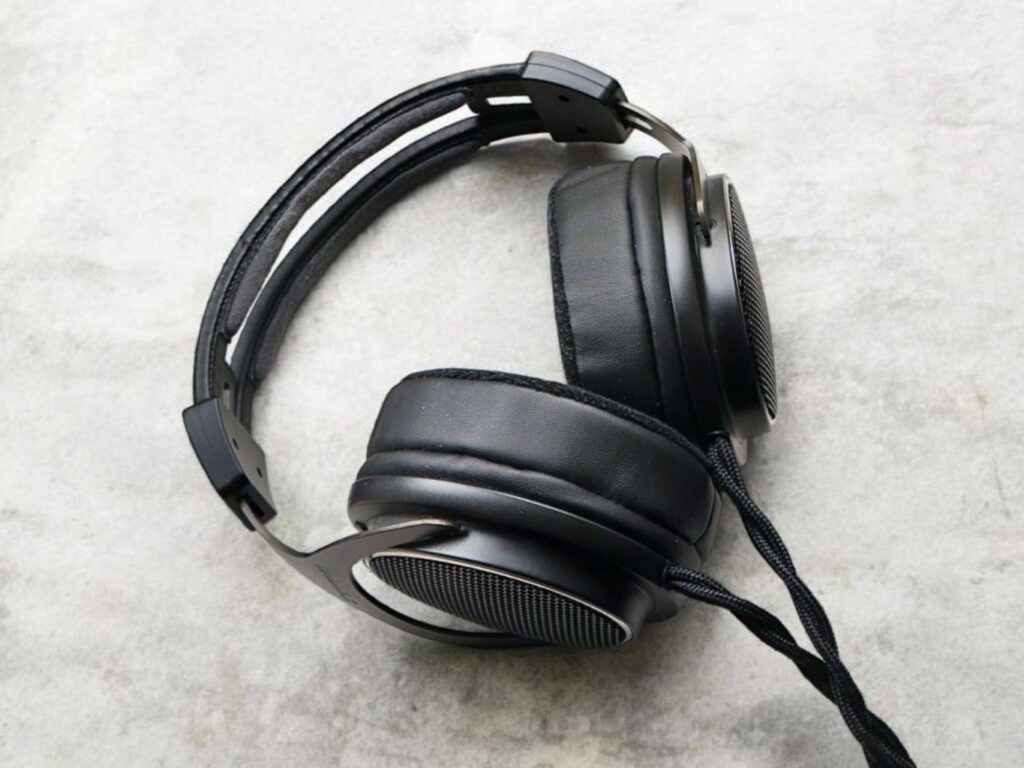
WRAPPING IT UP
Sound Signature
STOCK PADS: With the stock pads, the SRH1840 is a midrange-centric headphone. The treble is airy and pleasant, and the midrange is forward and engaging, standing out clearly in the mix. However, the bass is polite and restrained, and on certain electronic tracks, it can fall apart with noticeable distortion.
HYBRID PADS: With the Hybrid Pads, the SRH1840 transforms into a very different headphone. It delivers rich, well-balanced, and extended bass, a present and delicately nuanced midrange, and clear, delicate, and precise highs.
Treble
STOCK PADS: The treble is nice and airy, with good detail and smooth articulation. It’s consistently present—never harsh or fatiguing, yet never lacking in presence either.
HYBRID PADS: With the hybrid pads, the treble gains significantly in precision and clarity. It’s well-balanced in quantity and of excellent overall quality, enhancing detail without becoming harsh.
Midrange
STOCK PADS: The midrange is the heart of this headphone—where the magic truly happens. It’s dynamic, articulate, and impressively bright, clear, and crisp without sounding harsh. The presentation is upfront and highly engaging, making for a uniquely entertaining listening experience. In my view, this standout midrange is the sole compelling reason to choose this headphone with the stock pads.
HYBRID PADS: With the hybrid pads, the midrange improves noticeably in quality. It becomes cleaner, smoother, more nuanced, and more natural sounding. Due to the improved tonal balance, it doesn’t stand out as prominently, but it integrates more cohesively into the overall sound, enhancing realism and refinement.
Bass
STOCK PADS: The bass is definitely the Achilles heel of the SRH1840 with the stock pads. It rolls off gradually, similar to the Sennheiser HD600, but more critically, it distorts more readily than the HD600. On several electronic tracks, the distortion was simply too prominent to ignore. For most acoustic music and even rock, however, the bass performance is acceptable. The roll-off gives the bass a textured, lean character that can work well in less demanding genres.
HYBRID PADS: There is a massive and stunning improvement in bass quality, quantity, and extension when switching from the stock pads to the hybrid pads. The bass becomes deeper and richer than the HD600, with significantly better low-end presence. It’s well balanced and doesn’t feel rolled off. The only downside is that it can still distort on a few very challenging tracks, but just a fraction of what it does with the stock pads, and not worse than the HD600. For the most part, I’d call the bass excellent for a headphone of this type.
Soundstage and Imaging
STOCK PADS: The sound stage is not anything special. It is open but not very three dimensional. Both the sound stage and the imaging is very similar to the Sennheiser HD600.
HYBRID PADS: weather the hybrid pads the sound stage becomes slightly smaller and more closed in but the sense of diffuseness disappears completely and the imaging is excellent.
Detail, Dynamics, and Timbre
STOCK PADS: The detail level is not very impressive for the price, that was sets this headphone apart is the extreme degree of articulation in the mid range. It is just extremely dynamic and percussion and everything else that happens in the mid range area feels extremely snappy and alive. The tonality is neutral-to-bright. The midrange timbre is crisper than neutral, but it still feels natural and very captivating.
HYBRID PADS: with the hybrid pads the detailed level becomes significantly higher and it sounds like the driver has much better conditions to work and there is a lot less distortion to be heard all across the frequency spectrum. With the hybrid pads that detailed level is actually very good for the price. Dynamics are also excellent. There is also a very natural timbre 8n all regions, not only the midrange but now also the bass and treble.
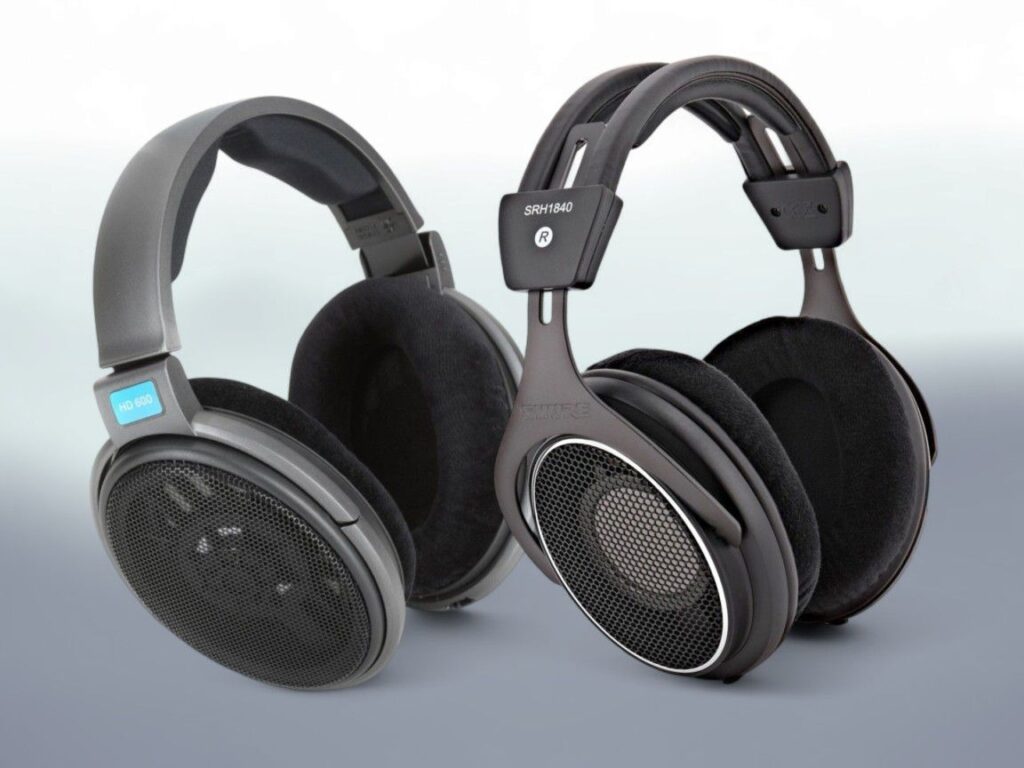
COMPARISONS
SENNHEISER HD600 vs SRH1840
The Sennheiser HD600 needs no introduction. I conducted a dedicated review comparing it with the Shure SRH1840, using both the stock pads and select third-party pads on the SRH1840.
In short, the two headphones share many similarities in their stock configurations—both are midrange-centric with comparable treble performance. However, the HD600 has the edge in bass quality, offering cleaner and more controlled low-end response, than the pretty disappointing SRH1840.
Both are strongest in the midrange, where they excel but with different character: the HD600 delivers a smooth and natural tone, while the SRH1840 presents a more dynamic, lively, and highly articulate rendition of vocals, instruments, and percussion. Nevertheless, in stock form, the HD600 is objectively the better headphone overall.
That said, if you equip the SRH1840 with well-selected third-party pads like the oval Hybrid Pads from Brainwavz, the tables turn dramatically. The SRH1840 transforms into a far more balanced headphone across the frequency spectrum, with bass that surpasses the HD600 in both quantity and quality. The midrange becomes smoother and more detailed, while the treble gains clarity and precision. Imaging also sees a significant improvement. In this configuration, the SRH1840 outperforms the HD600 in virtually every area.
Read more: HD600 vs SRH1840 Comparison Review
- Amazon: HD600
NEUMANN NDH30 vs SRH1840 with Hybrid Pads
First, the Neumann NDH30 is a significantly better headphone than the stock SRH1840. It offers more and higher-quality bass, a more accurate tonal balance, greater detail, and superior imaging. In most respects, the NDH30 feels like a refined, more technically capable version of the HD600.
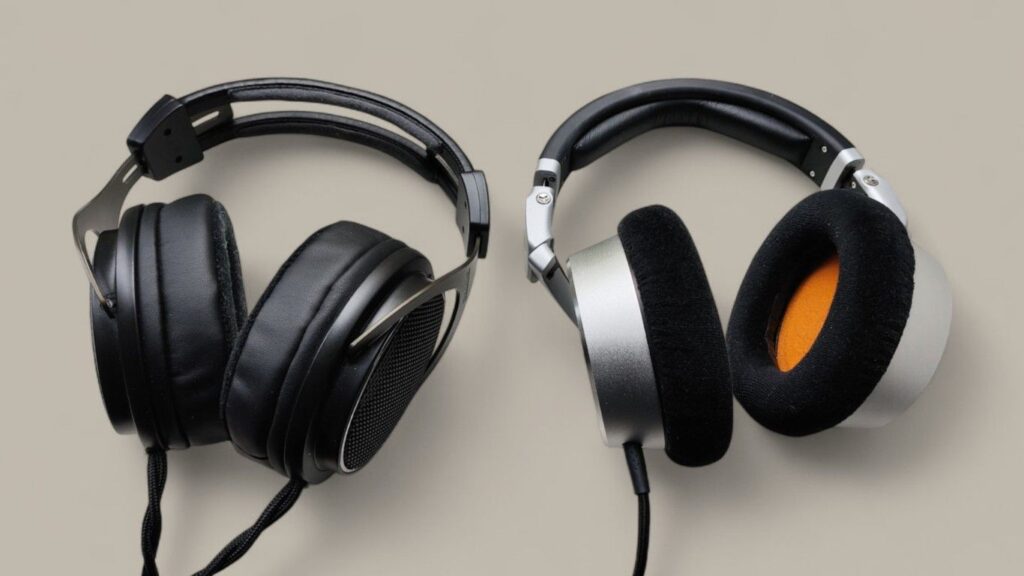
That said, as with the HD600, if you equip the SRH1840 with some well selected third party pads like the oval hybrid pads from Brainwavz, the tables change. The bass becomes better in quantity in the extensions and better quality, the mid range is cleaner and the treble is clearer and much less diffuse. The imaging is also improved compared to the NDH30. The NDH30 is good, but with the alternative pads, the SRH1840 is even better.
Now, it would’ve been very interesting to do some pad swapping on the Neumann NDH30 as well—but that’ll have to be a topic for a future review.
- Amazon: NDH30
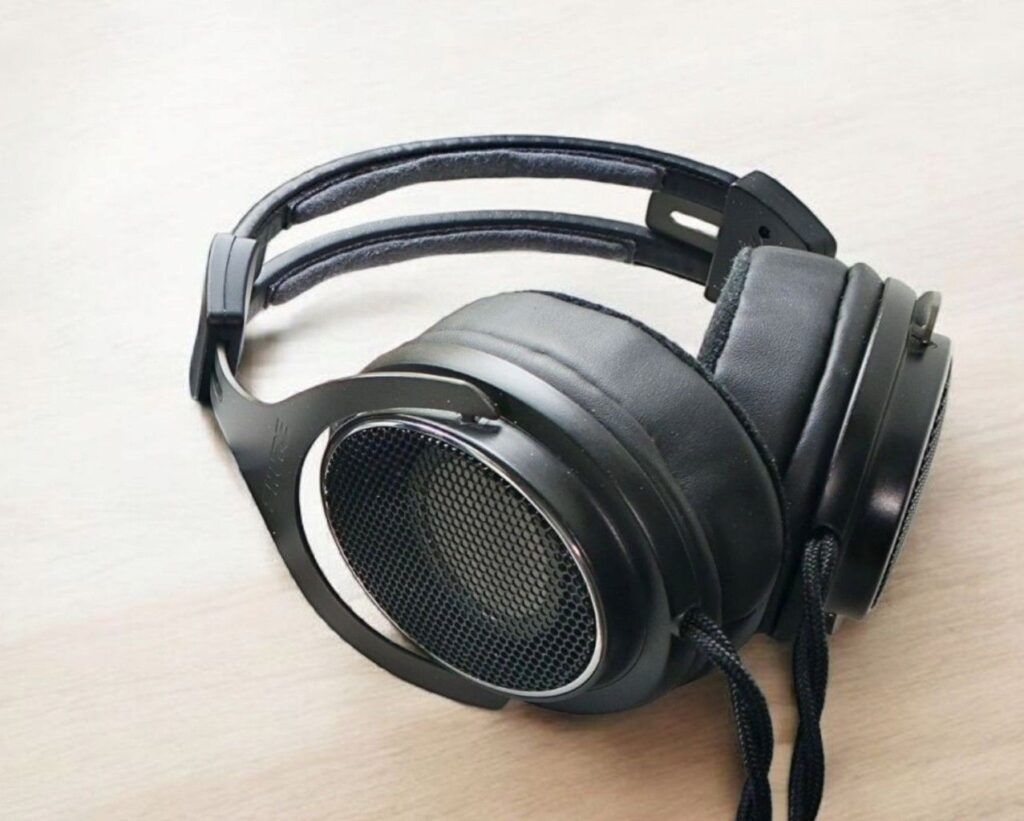
CONCLUSION
With its stock pads, the Shure SRH1840 is a decent headphone with a few strengths, but the weaknesses make me consider it partly flawed.
The stock SRH1840 delivers a crisp, articulate midrange and pleasant, non-fatiguing treble, making it a compelling choice for vocal and acoustic-focused music. However, it suffers from notably weak and distorted bass, limited low-end extension, and an overall midrange centric tonal balance, issues that are hard to justify at its price point.
With the Hybrid Pads (or similarly performing third party pads), however, the SRH1840 transforms dramatically. The bass becomes deeper, cleaner, and better controlled, the midrange smoother and more refined without losing its signature energy, and the treble clearer, cleaner, and more focused. Imaging and overall tonal balance also improve significantly.
In this modified form, the SRH1840 is no longer a flawed headphone—quite the opposite. It evolves into a standout performer, fully competitive at its price point and even exceeding expectations in several areas. The stock pads are clearly the main flaw holding it back, and it’s genuinely puzzling, and very disappointing, that Shure hasn’t addressed this with an updated version with improved pad design.
With the stock pads, I cannot recommend the SRH1840. However, for those willing to do a simple pad swap to more suitable alternatives, the SRH1840 transforms into a hidden gem that delivers an amazingly well balanced and enjoyable listening experience.
Thanks for reading. You can support us by purchasing anything using any of our affiliate links.
Any purchase you make on Amazon or Linsoul with any of our affiliate links will give us a small provision at no cost to you.
We only get a provision for items that are not returned, so there’s no incentive for us to recommend something that’s not good.
Linsoul : Headphones, Earbuds, Wireless Earbuds, Desktop DAC/AMP, Portable DAC/AMP, Digital Audio Players,
Amazon: Headphones, IEMs, Headphone Amplifiers, Home Audio or Anything else.
.
If you enjoyed this article or other content on The Headphoneer, you might consider leaving a small donation to keep this website up and running. No donation is too small. Thanks for supporting us!
If you like our work please follow us on Instagram, Facebook and Twitter , it will help us grow. Sharing is caring 🙂


